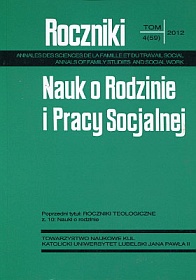Family and Environmental Determinants of Unplanned Shopping
Abstract
We are living in times that researchers call the times of consumerism. Purchasing, using and consuming ever more clearly become an integral part of a new global culture called consumer culture. In forming behaviors and the hierarchy of values in an adult man his closest environment, and especially his family and his acquaintances, play a significant role. Hence pathogenic factors that are the cause of occurrence of various kinds of disturbances should be searched for also in the family and social systems. Analysis of the possible causes of occurrence of unplanned shopping in the family and social environment supplies many hypotheses that should be verified in an empirical way.
References
Bandura A.: Teoria społecznego uczenia się, Warszawa: PWN 2007.
Benmoyal-Bouzaglo S., Moschis G. P.: The Effects of Family Structure and Socialization Influences on Compulsive Consumption: A Life Course Study in France, „International Journal of Consumer Studies” 33(2009), s.49-57.
Black D. W., Repertinger S., Gaffney G. R., Gabel J.: Family History and Psychiatric Comorbidyty in Persons with Compulsive Buying: Preliminary Findings, „American Journal of Psychiatry 155(1998), nr 7, s. 960-963.
Bogunia-Borowska M.: Dziecko w kulturze konsumpcyjnej – infantylizacja kultury jako konsekwencja narodzin podmiotu rynkowego, [w:] Konsumpcja – istotny wymiar globalizacji kulturowej, red. A. Jawłowska, M. Kempny, Warszawa: Wyd. IFiS PAN 2005, s. 150-163.
Chien-Huang L., Hung-Ming L.: An Exploration of Taiwanese Adolescents' Impulsive Buying Tendency, „Adolescence” 40(2005), nr 157, s.215-223.
Doliński A.: Zachowania młodzieży w sytuacjach społecznych jako transmisja wzorów rodzinnych, Kraków: Oficyna Wydawnicza „Impuls” 2004.
Faber J. R., O'Guinn T. C.: Compulsive Buying: Review and Reflection, [w:] Handbook of Consumer Psychology, red. C. P. Haugtvedt, P. Herr, F. Kardes, Mahwah: Lawrence Erlbaum Associates 2006 s. 2-23.
Faber J. R., O'Guinn T. C.: Dysfuncional Consumer Socialization: A Search for the Roots of Compulsive Buying, [w:] Psychology in Micro and Macro Economics, red. P. V. Abeele, Leuven: International Association for Research in Econimic Psychology 1988, s. 5-17.
Gąsiorowska A.: Kupowanie kompulsywne – zjawisko, jego determinanty ikonsekwencje: przegląd badań, „Przegląd Psychologiczny” 44(2001), nr 4, s.463-477.
Hall C. S., Lindzey G., Campbell J. B.: Teorie osobowości, Warszawa: WN PWN 2006.
Hobfoll S. E.: Stres, kultura i społeczność. Psychologia i filozofia stresu, Gdańsk: GWP2006.
Hoffmann B.: Styl ubierania się czynnikiem kształtowania tożsamości młodzieży, „Problemy Opiekuńczo-Wychowawcze” 2007, nr 10, s. 28-32.
Mallalieu L., Palan K. M.: Conceptualizing Teenage Girls' Preceived Shopping Competence, „Academy of Marketing Sciences Review” 2006, nr 5, s.1-17.
Mandal A.: Nowe nałogi współczesnego człowieka, „Problemy Opiekuńczo-Wychowawcze” 2006, nr 7, s. 11-15.
Mącik D.: Między przyjemnością a uzależnieniem. Psychologia zakupów nieplanowanych, Toruń: WN GRADO 2008.
McElroy L., Keck P. E., Pope H. G., Smith J. M. R., Strakowski S. M.: Compulsive Buying: AReport of 20 Cases, „Journal of Clinical Psychiatry” 55(1994), nr 6, s.242-248.
Oleś P.: Wprowadzenie do psychologii osobowości, Poznań: SCHOLAR 2005.
Paluchowski W. J., Okarma A.: Kompensacyjna funkcja symbolicznej konsumpcji, [w:]Psychologia a rynek zachowania konsumentów, red. W. J. Paluchowski, G.Bartkowiak, Poznań: Rys 2004, s. 223-250.
Raczkowska J.: Dzieci i młodzież w świecie mamony, „Problemy Opiekuńczo-Wychowawcze” 2006, nr 5, s. 27-35.
Tavares H.: Impulse Control Disorders: The Return of Esquirol's Instinctive Monomania, „Revista Brasileira de Psiquiatria” 30(2008), nr 1, s. 1-2.
Tavares H., Lobo D. S., Fuentes D., Black D. W.: Compulsive Buying Disorder: A Review and a Case Vignette, „Revista Brasileira de Psiquiatria” 30(2008), nr 1, s. 16-23.
Urząd Ochrony Konkurencji i Konsumentów: Polacy na zakupach w Internecie, Warszawa 2008.
Woodruffe-Burton H., Elliot R.: Compensatory Consumption and Narrative Identity Theory, „Advances in Consumer Research” 32(2005), s. 461-465.
Valkenburg P. M., Cantor J.: The Development of a Child Into aConsumer, „Applied Developmental Psychology” 2001, nr 22, s. 61-72.
Vohs K., Faber J. R.: Spent Resources: Self-Regulatory Resource Availability Affects Impulse Buying, „Journal of Consumer Research” 33(2007), s. 537-547.
Xueming L.: How Does Shopping With Others Influence Impulsive Purchasing?, „Journal of Consumer Psychology” 15(2005), nr 4, s. 288-294.
Zadłużna E., Paluchowski W. J.: Konsumpcja symboliczna i jej znaczenie, [w:] Psychologia a promocja. Zachowania konsumentów, red. W. J. Paluchowski, G.Bartkowiak, Poznań: Wyd. „Rys” 2004, s. 115-132.
Zawadzki R., Chuchra M.: Rola czynników motywacyjnych w etiologii zakupów nieplanowanych, „Current Problems of Psychiatry” 11(2010), nr 3, s.211-218.

